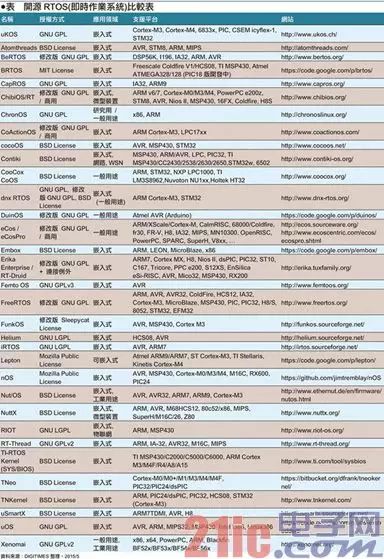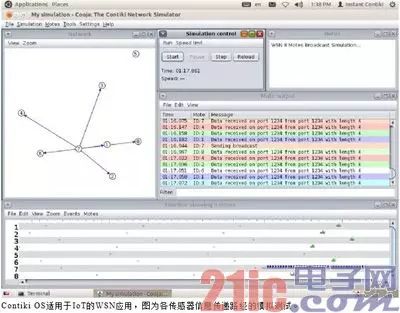Microcontrollers (MCUs) are widely used across various industries, such as home appliances, industrial automation, real-time control, and data collection. To meet the demands for real-time control and quick responses in industrial control, most MCUs are equipped with Real-Time Operating Systems (RTOS). With the rise of the Internet of Things (IoT), the software industry has also integrated IoT components into RTOS to secure a position in the core software market of IoT…

Operating Systems for Various Processors
In the general-purpose processor market classification, if we categorize based on functionality and execution speed, it can be roughly divided into CPU > MPU > MCU. CPUs are the most powerful, mainly used in computer products; MPUs are less powerful, with diverse applications, mainly used in embedded systems and compact computers; while MCUs are primarily focused on single applications, used in various home appliances, electronic products, embedded products, wearable devices, and IoT applications.



MCUs integrate a CPU operating at KHz to MHz, memory units (RAM and ROM/EEPROM/Flash) ranging from KB to MB, clock generators (Oscillator; Clock Generator), and I/O expansion units, making them a type of slower system-on-chip (SoC).
Due to the small internal memory capacity, it is impossible to run large operating systems like Windows or Linux on MCUs, and since MCUs are mostly used in real-time control environments, many small-capacity RTOS (Real-Time Operating Systems) have become the main platform for developing MCU software.

Mid to High-End RTOS for Embedded Applications
There are various types of RTOS, primarily designed for embedded systems based on MPU or MCU. For example, powerful RTOS designed for MPU level include Integrity, QNX, and VxWorks; while smaller RTOS primarily supporting MCU levels include Nucleus, ThreadX, Unison OS, ucOS II/III, etc.
For instance, Integrity OS released by Green Hills Software is an RTOS mainly supporting MPU (and even CPU levels). Its strength lies in the Integrity-178 version, which has passed EAL 6+ (information security) certification and DO-178B (aviation safety) Level A certification, used in markets that emphasize safety and reliability, such as fighter jets (like B-2, F-16, F-22, F-35) and commercial aircraft (like Airbus A380). This RTOS supports CPU/MPU platforms including ARM, XScale, Blackfin, Freescale (now part of NXP) ColdFire, MIPS, PowerPC, and AMD x86 (embedded APU).
Another well-known QNX RTOS adopts a microkernel architecture and is the only OS that has successfully entered the commercial market, excelling in real-time multimedia processing capabilities, suitable for embedded markets such as in-car entertainment devices and mobile phones. QNX was acquired by BlackBerry in 2010, which developed the BB 10 operating system. QNX supports CPU/MPU platforms including IA32, MIPS, PowerPC, SH-4, ARM, StrongARM, and XScale.
RTOS like IntervalZero’s RTX and RTX64 are designed to coexist with Microsoft Windows, paired with EtherCAT protocol for factory automation applications. In this setup, Windows handles GUI, storage, and computation, while RTX manages real-time industrial control and data collection, making industrial control software development easier. The above RTOS are MB to GB level MPU OS, not suitable for MCU environments.

Commercial RTOS Focused on MCU Applications
Mid to low-end RTOS primarily aim to minimize software functionality to MB or even KB levels, allowing the entire OS and main application to fit into the MCU’s ROM/EEPROM/Flash. Given the broader application fields of MCUs, their software must be even more streamlined, hence MCU-specific RTOS often feature highly modular architectures, allowing custom solutions for core, drivers, file systems, peripheral I/O, network support, etc., facilitating faster time-to-market.
Some commercial RTOS provide source code to authorized customers, while open-source RTOS offer greater freedom, allowing developers to compile the smallest, optimized execution environments.
Since each chip manufacturer releases corresponding OS and IDE (Integrated Development Environment) for their MCU products, these OS and development environments may only be suitable for that manufacturer’s MCU products. Therefore, third-party software vendors develop cross-chip/cross-hardware platform OS and IDE, allowing developers to avoid rewriting software when changing hardware platforms.
Currently, the highest market share in the MCU OS/IDE market is held by commercial RTOS offered by software companies (paired with various manufacturers’ MCU products). However, with ARM’s introduction of instruction set architectures like Cortex-M and Cortex-R targeting wearable and IoT applications, the trend of RTOS based on ARM architecture (using open source) has begun to rise.
Nucleus, released by Mentor Graphics’ Accelerated Technology, adopts a Microkernel design, boasting 3 billion device integrations, with the advantage of a core size as small as 2KB, and developers do not need to write embedded device-specific BSP (Board Support Package), making it widely used in consumer electronics, mobile devices, automotive electronics, smart energy, medical instruments, industrial control, and other fields.
Early Chinese counterfeit, white-label, dual-SIM 2G phones using MediaTek MT6217 chips executed the Nucleus RTOS. This RTOS supports embedded MCU architectures including ARM, MicroBlaze, MIPS, Nios II, Power, SuperH, and XScale.
ThreadX, launched by Express Logic, is a royalty-free RTOS known for its ultra-fast boot time and response time, with a Picokernel core size of less than 2KB, and it has passed safety standards, claiming 2.1 billion device integrations. For example, HP’s printers and transaction machines use this RTOS. It widely supports various 32-bit MCUs, including ARM, Atmel, BlackFin, CoreFire/68K, EFM32, Freescale (NXP), FM3, H8, XMC, M-Core, MicroBlaze, MIPS, Nios II, Power, STM32, StrongARM, Synopsys ARC, TI, Win32, x86/x386, and XScale.
VxWorks, released by Wind River, is primarily designed for embedded systems, adopting a Monolithic core, with advantages such as preemptive multitasking, cyclic execution, and quick response to interrupts, natively supporting 64-bit processor architectures (x64), capable of parallel (SMP) and non-parallel (AMP) processing, with over 1.5 billion device integrations to date.
The latest VxWorks 7 strengthens scalability, security, connectivity, graphics capabilities, and virtualization needed for IoT, with the full-featured VxWorks microkernel size only requiring 20KB.
VxWorks is widely adopted in the technology industry, with the Mars rover Curiosity using VxWorks. This RTOS supports Intel x86 (including Quark SoC and x86-64), MIPS, PowerPC, SH-4, and ARM CPU/MPU architectures.
RoweBots’ Unison OS is a fully POSIX-compliant RTOS suitable for MCU, DSC, DSP, SoC, FPGA, and other 32-bit hardware development environments, particularly enhancing system security for IoT applications, and the core program code can be as low as 1KB in certain application architectures. It supports 32-bit MCUs including Microchip PIC32, Renesas R32C/SH2A, ST STM32, and TI ARM Cortex-M3.
Micrium’s μc/OS-II (microcontroller OS version 2) focuses on portability, execution in ROM, flexibility, and preemptive multitasking RTOS core, managing up to 250 application tasks. μc/OS-III emphasizes unlimited application tasks, near-zero interrupts, and provides source code to customers.
Its advantages include open, clean, and consistent source code with detailed annotations, and it has passed FAA certification and DO-178B certification, suitable for various embedded and IoT system development, with core sizes ranging from 5 or 6KB to 24KB. The μc/OS-III HW-RTOS is designed for hardware acceleration based on ARM Cortex-M MCUs. This RTOS supports over 100 types of DSP, MPU, and MCU.

ARM MCU Drives the Rise of Open Source RTOS
In recent years, due to the ARM architecture processors sweeping the global smart mobile device (phones/tablets) market, in addition to the commercial RTOS/IDE launched with various MCU/MPU hardware platforms, ARM has introduced the Cortex-M and Cortex-R instruction set architectures to penetrate the MCU-level applications in IoT and wearable devices, paired with open-source OS/IDE to capture the MCU application market.
For example, the mbed OS and related development environment launched by ARM focus on embedded devices and IoT applications, featuring connectivity, efficiency, security, and productivity, also serving as RTOS applications with its mbed-rtos library. The mbed development environment can develop smart home, smart city, and wearable applications.
Moreover, there are many open-source RTOS/IDE launched for ARM platforms, such as FreeRTOS, uKOS-II, Atomthreads, BeRTOS community edition, ChibiOS/RT, CoActionOS, eCos, Embox, Erika Enterprise/RT-Druid, Keil (ARM) RTX, Lepton, nOS, Nut/OS, NuttX, RIOT, RT-Thread, TI-RTOS-KERNEL (SYS/BIOS), TNeo, etc., providing developers with more choices.

Overview of Other Non-Real-Time OS for Dedicated MCUs
Additionally, there are many open-source OS (non-RTOS) designed for MCUs that also feature small sizes, some aimed at IoT WSN (Wireless Sensor Network) applications, such as Contiki OS and TinyOS. Others feature general desktop graphical user interfaces (GUIs), such as SymbOS and Wheels OS.
Contiki OS is an open-source micro OS that can be applied to Atmel ARM/AVR, LPC, PIC32, TI MSP430/CC2430/2538/2630/2650, STM32W, etc., for IoT applications, and can even run on vintage 8-bit computers (Apple II, Atari, Commodore, etc.) for internet connectivity, or even on retro gaming consoles (Atari Jaguar, Game Boy/Advance, GP32, Nintendo Entertainment System, PC Engine, etc.).
SymbOS is a free multimedia graphical operating system that can run on 8-bit Z80 CPUs (such as MSX, Amstrad), providing a Windows 95-like interface to revive old computers.
Special Recommendations




